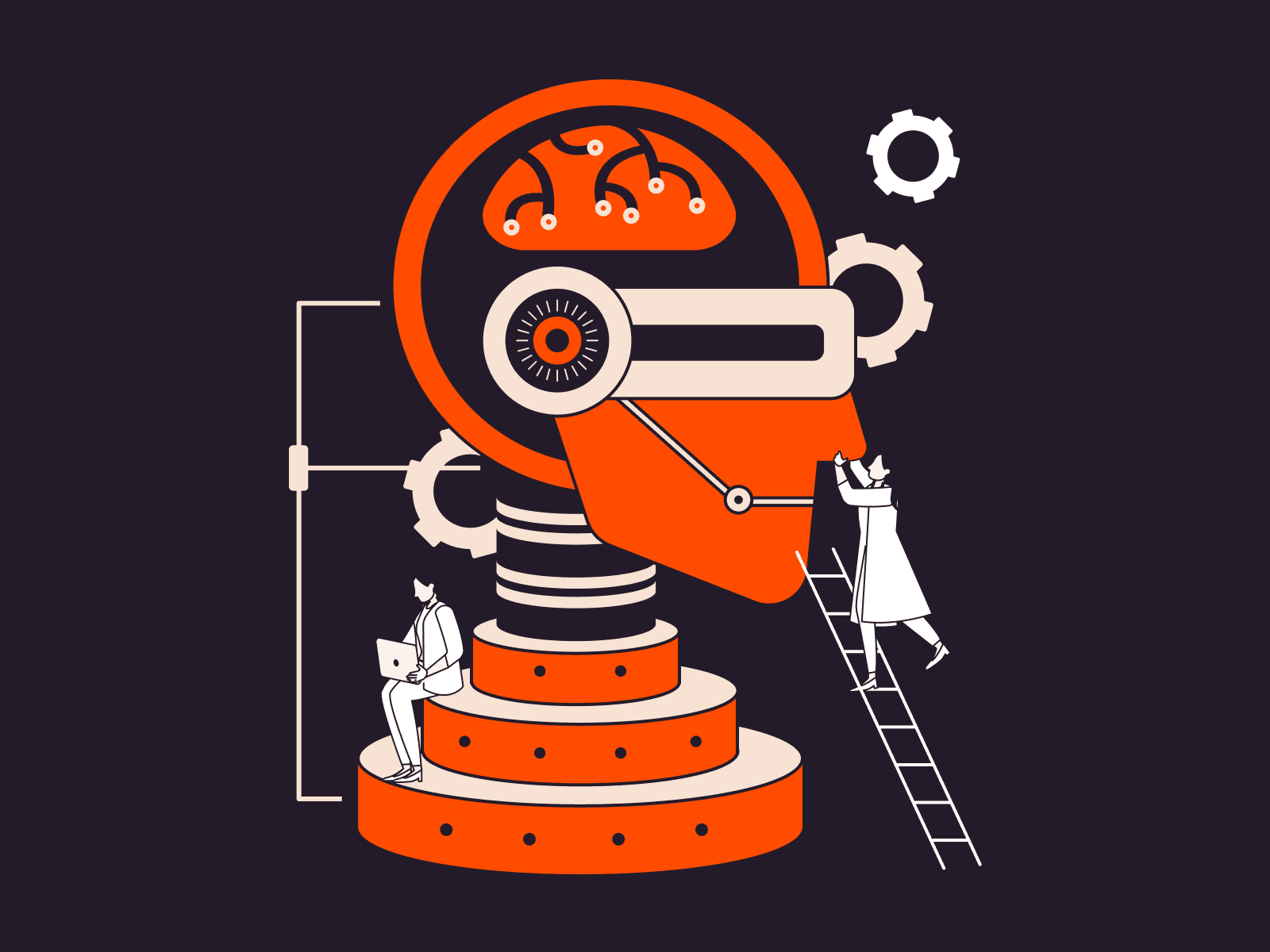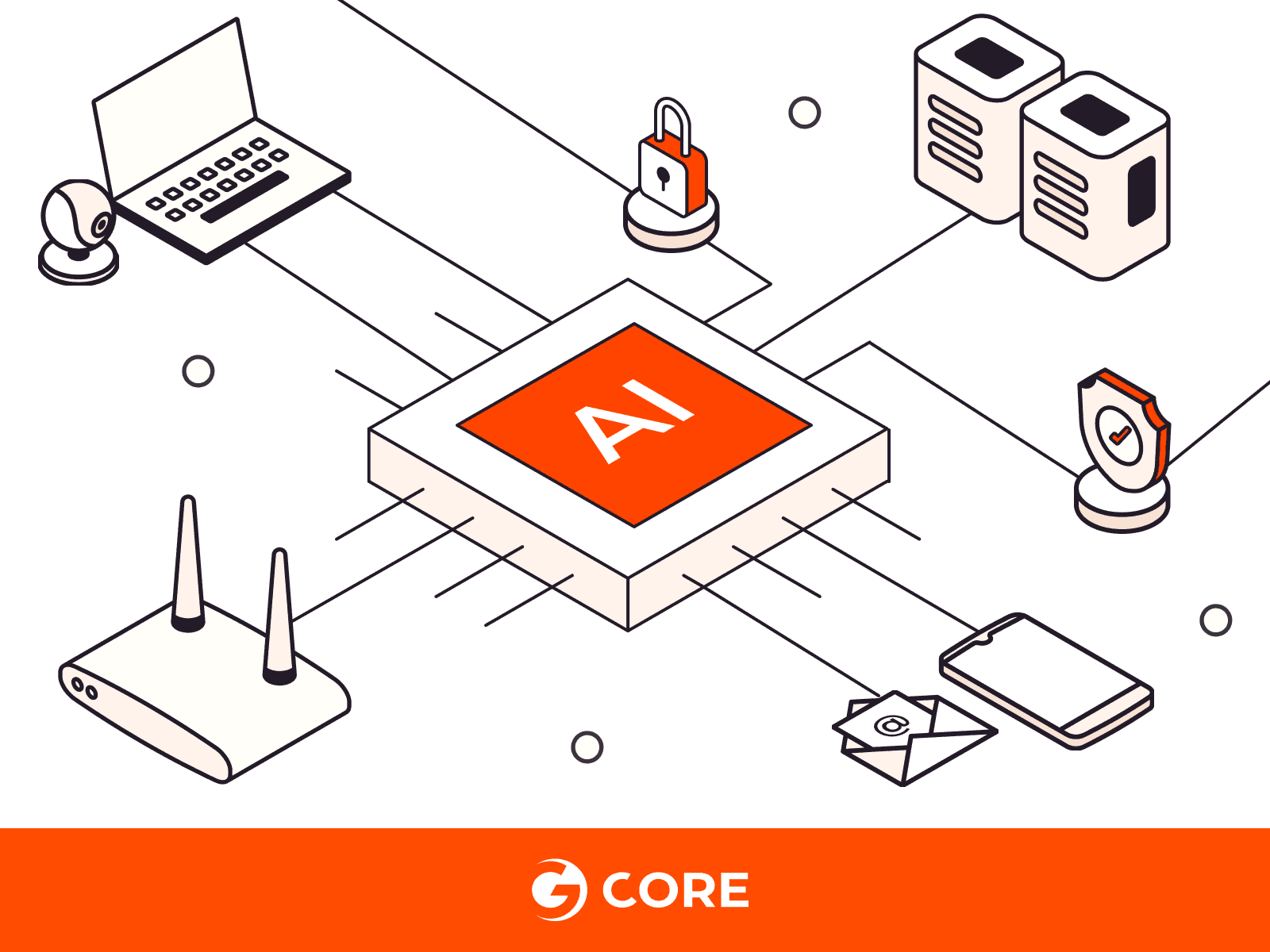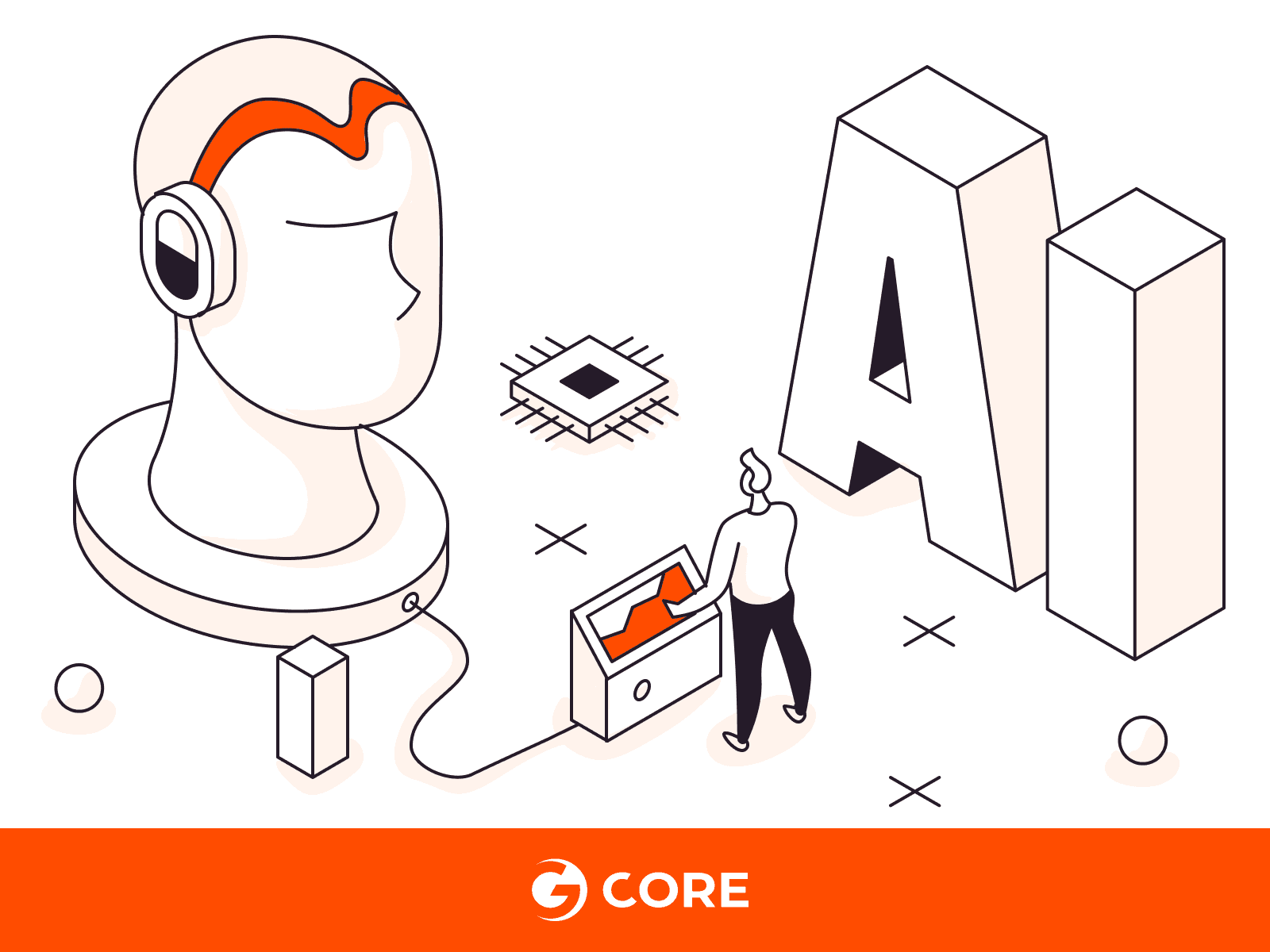Die Entwicklung der KI-Infrastruktur: Der Übergang von On-Premise zur Cloud und zur Edge
- Von Gcore
- April 26, 2024
- 9 Min.

Die KI-Infrastruktur, das Rückgrat der modernen Technologie, hat einen bedeutenden Wandel erfahren. Ursprünglich war sie in traditionellen On-Premises-Konfigurationen verwurzelt, hat sich allerdings zu dynamischeren, cloudbasierten und Edge-Computing-Lösungen entwickelt. In diesem Artikel werfen wir einen Blick auf die treibenden Kräfte hinter diesem Wandel, die Auswirkungen auf große und kleine Unternehmen und die neuen Trends, die die Zukunft der KI-Infrastruktur bestimmen.
Wie hat sich die KI-Infrastruktur entwickelt?

Die rasante Entwicklung der Technologie und die damit einhergehende Verlagerung der KI-Infrastruktur von vor Ort in die Cloud und dann zum Edge Computing stellt eine grundlegende Veränderung der Art und Weise dar, wie wir Daten verarbeiten, speichern und darauf zugreifen. Werfen wir einen Blick auf die Geschichte der KI-Infrastruktur, um zu zeigen, wie diese Entwicklung vonstattenging.
Die KI-Infrastruktur wurde traditionell vor Ort aufgebaut, d. h. alle Server, Speicher und Netzwerke, die KI-Anwendungen unterstützen, befanden sich in den physischen Räumlichkeiten eines Unternehmens. Um dieses Ziel zu erreichen, unterhielten die Unternehmen Server, auf denen die Anwendungen direkt installiert und verwaltet wurden.
Im Jahr 1997 wurde Cloud Computing erstmals definiert. Damit wurde der Grundstein für die spätere Cloud-KI-Infrastruktur gelegt, die es Unternehmen ermöglicht, leistungsstarke KI-Funktionen zu nutzen, ohne erhebliche Anfangsinvestitionen in physische Hardware tätigen zu müssen. Stattdessen ist die Cloud-KI-Infrastruktur darauf ausgelegt, KI-Anwendungen zu unterstützen, indem sie ihnen die enorme Rechenleistung und die Datenverwaltungsfunktionen zur Verfügung stellt, die sie benötigen, um in einer zentralisierten, über das Internet zugänglichen Umgebung effektiv zu arbeiten.
Die Cloud-KI-Infrastruktur umfasst mehrere wesentliche Komponenten. Die verteilte Verarbeitung, bei der große Datensätze in kleinere Segmente aufgeteilt werden, die dann gleichzeitig auf mehreren Rechnern verarbeitet werden, kann die Trainingsgeschwindigkeit und die Rechenleistung von KI erheblich steigern. Allerdings erfordert diese Methode robuste Netzwerkgeschwindigkeiten und eine sorgfältige Koordination, um effektiv zu sein. Trotz dieser Herausforderungen übertrifft die verteilte Verarbeitung, wenn sie erfolgreich implementiert wurde, bei weitem die Fähigkeiten herkömmlicher Systeme mit nur einem Server bei der Verarbeitung komplexer Berechnungen.
Dienste für maschinelles Lernen rationalisieren die Entwicklung und den Einsatz von KI-Modellen, indem sie Tools bereitstellen, die Aufgaben wie Modelltraining und Inferenz automatisieren. Anstatt Algorithmen manuell zu kodieren, können Entwickler diese Dienste nutzen, um vorgefertigte Modelle auszuwählen, die ihren Anforderungen entsprechen. APIs (Application Programming Interfaces) und SDKs (Software Development Kits) vereinfachen den Integrationsprozess weiter und ermöglichen es Entwicklern, ihre Anwendungen problemlos mit KI-Funktionen zu erweitern. Das bedeutet, dass Sie komplexe Funktionen wie Bilderkennung oder die Verarbeitung natürlicher Sprache hinzufügen können, ohne umfangreichen neuen Code schreiben zu müssen.
Die Recheninfrastruktur in der Cloud kann komplexe KI-Aufgaben, wie die Verarbeitung großer Datensätze und die Ausführung anspruchsvoller Algorithmen, effizient durchführen. Darüber hinaus sind die Überwachungs- und Verwaltungstools mit Funktionen wie Echtzeitanalysen und automatischen Warnmeldungen ausgestattet, die sicherstellen, dass KI-Systeme optimal funktionieren. Diese Tools können die Systemparameter auf der Grundlage von Leistungsdaten automatisch anpassen, z.B. die Rechenleistung in Zeiten hoher Nachfrage erhöhen oder die Ressourcenzuweisung optimieren, um die Effizienz zu verbessern.
In jüngster Zeit, im Jahr 2020, verlagerte sich der Schwerpunkt auf Edge-KI. Dieses Modell verlagert von KI gesteuerte Inferenzprozesse an den Ort des Bedarfs, sei es auf ein lokales Gerät oder einen nahegelegenen Computer, und reduziert so die Latenzzeit, indem es die Notwendigkeit vermeidet, Daten zu weit entfernten Servern oder Cloud-Systemen hin und her zu senden. Das Training von KI-Modellen kann zentral erfolgen, da es die Endbenutzererfahrung nicht durch Latenzzeiten beeinträchtigt.
Was die Speicherung anbelangt, so können die Trainingsdatensätze zwar zentralisiert werden, aber die Datenbanken für RAG-Modelle (Retrieval-Augmented Generation), die dynamisch mit den operativen Modellen interagieren, sollten sich am Rand befinden, um die Reaktionszeiten und die Leistung zu optimieren.
Wie sich die Entwicklung der KI-Infrastruktur auf den Tech Stack auswirkt
Die Wahl der KI-Infrastruktur – ob On-Premise, in der Cloud oder im Edge-Bereich – kann die verschiedenen Ebenen des Tech Stacks eines Unternehmens, die zur Entwicklung und Bereitstellung von Anwendungen verwendeten Technologien, Software und Tools sowie die gesetzlichen Anforderungen zum Schutz der verarbeiteten Daten erheblich beeinflussen.
Ein Tech Stack ist im Wesentlichen die Bausteine eines jeden Softwareprojekts, einschließlich KI. Im Falle der KI besteht er aus drei Hauptschichten:
- Anwendungsschicht: Diese Schicht ist die Schnittstelle, über die Nutzer mit der Software interagieren. In der Regel handelt es sich dabei um nutzerorientierte Anwendungen, die auf Open-Source-KI-Frameworks aufgebaut sind, die an spezifische Geschäftsanforderungen angepasst werden können, sowie um allgemeine nutzerorientierte Anwendungen, die nicht direkt mit KI in Verbindung stehen, aber durch sie erweitert werden.
Die von Ihnen gewählte KI-Infrastruktur wirkt sich auf folgende Weise auf die Anwendungsschicht aus:
- On-Premise: Die Integration mit anderen Diensten kann komplex sein und erfordert möglicherweise maßgeschneiderte Lösungen, die die Innovation bremsen.
- Cloud: Cloudbasierte KI vereinfacht die Anwendungsbereitstellung mit vorgefertigten Integrationen und APIs, sodass Sie Ihre KI nahtlos mit bestehenden Systemen verbinden können. Dadurch wird die Entwicklung optimiert und die Einbindung neuer Funktionen oder Datenquellen erleichtert.
- Edge: Edge-KI könnte die Komplexität der Anwendungen für den Nutzer aufgrund der geringeren Verarbeitungsleistung von Edge-Geräten einschränken. Sie kann jedoch Anwendungen verbessern, die eine Datenverarbeitung in Echtzeit erfordern, wie z. B. Verkehrsmanagementsysteme.
- Modellschicht: Auf dieser Schicht werden KI-Modelle entwickelt, trainiert und eingesetzt. Sie besteht aus Kontrollpunkten, die KI-Produkte antreiben und für die Bereitstellung eine Hosting-Lösung benötigen. Diese Schicht wird von der Art der verwendeten KI beeinflusst, ob allgemein, spezifisch oder hyperlokal, die jeweils ein unterschiedliches Maß an Präzision und Relevanz bieten.
Ihre Wahl der KI-Infrastruktur wirkt sich wie folgt auf die Modellschicht aus:
- On-Premise: Das Training komplexer Modelle erfordert oft erhebliche Investitionen in Hardware, die sich nicht flexibel an unterschiedliche Leistungsanforderungen anpassen lässt. Wenn diese Geräte nicht voll ausgelastet sind, verursachen sie Kosten, ohne einen Mehrwert zu schaffen, und ein schneller Austausch oder ein Upgrade leistungsschwacher Hardware kann schwierig sein. Diese Starrheit birgt erhebliche Risiken, insbesondere für Start-ups, die operative Flexibilität benötigen.
- Cloud: Cloud-Plattformen bieten einfachen Zugang zu riesigen Computerressourcen, um selbst die kompliziertesten Modelle zu trainieren; ideal für Start-ups. Darüber hinaus ermöglicht die cloudbasierte Bereitstellung automatische Updates für alle Instanzen, was die Effizienz erhöht und gleichzeitig flexible Angebote und Preismodelle bietet.
- Edge: Die begrenzte Rechenleistung von Edge-Geräten kann die Art der Modelle, die sich trainieren lassen, einschränken. Edge-KI eignet sich jedoch hervorragend für Szenarien, die eine geringe Latenzzeit erfordern, wie die Erkennung von Anomalien in Industrieanlagen in Echtzeit.
- Infrastrukturschicht: Diese Schicht besteht aus den physischen und Softwarekomponenten, die die Grundlage für die Entwicklung, den Einsatz und die Verwaltung von KI-Projekten bilden. Dazu gehören APIs, Datenspeicher- und Verwaltungssysteme, Frameworks für maschinelles Lernen und Betriebssysteme. Diese Schicht versorgt die Anwendungs- und Modellschichten mit den notwendigen Ressourcen.
Natürlich wirkt sich die von Ihnen gewählte KI-Infrastruktur auch direkt auf die Infrastrukturschicht selbst aus:
- On-Premise: Die Verwaltung aller Hardware- und Softwarekomponenten im eigenen Haus, einschließlich der Datenspeicher- und Sicherheitssysteme, erfordert ein eigenes IT-Team und beinhaltet die Verwaltung des gesamten Hardware-Lebenszyklus: von der Beschaffung von Ersatzteilen und der Aktualisierung der Firmware bis hin zur Umstellung auf neue Modelle und dem Recycling alter Hardware.
- Cloud: Cloud-Anbieter kümmern sich um die zugrunde liegende Infrastruktur, sodass Sie sich auf die eigentliche KI-Entwicklung konzentrieren können. Cloud-Dienste bieten integrierte Sicherheitsfunktionen und leicht verfügbare Frameworks für maschinelles Lernen, sodass weniger internes Fachwissen erforderlich ist.
- Edge: Die Verwaltung eines Netzwerks von Edge-Geräten kann komplex sein und erfordert im Gegensatz zu zentral verwalteten Cloud-Lösungen spezielle Verfahren für Software-Updates und Sicherheits-Patches. Edge-KI kann jedoch die Belastung Ihrer Kerninfrastruktur verringern, indem sie Daten lokal verarbeitet und den Bedarf an Datentransfer minimiert.

On-Premise vs. Cloud vs. Edge-KI
Da Sie nun wissen, wie sich die KI-Infrastruktur entwickelt hat und welche Rolle sie innerhalb des Tech Stack spielt, lassen Sie uns die drei Infrastrukturtypen vergleichen, um festzustellen, welche für Ihr Unternehmen am besten geeignet sein könnte.
| Infrastrukturtyp | On-Premise | Cloud | Edge |
| Definition | KI-Computing-Infrastruktur, die sich in den physischen Räumlichkeiten des Unternehmens befindet | KI-Dienste und -Ressourcen, die nach Bedarf über das Internet von den Rechenzentren eines Cloud-Service-Anbieters aus angeboten werden | Verteiltes Computing, das KI-Datenerfassung, -Analyse, -Training, -Schlussfolgerungen und -Speicherung näher an den Ort bringt, an dem sie benötigt werden |
| Wichtige Komponenten | Server, Speichersysteme, Netzwerkhardware | Virtuelle Server, skalierbarer Speicher, Netzwerktechnologie | Edge-Server, IoT-Geräte, lokale Netzwerke |
| Vorteile | Bietet Unternehmen eine größere Kontrolle über ihre Infrastruktur und Datenverwaltung und ermöglicht maßgeschneiderte Sicherheitsmaßnahmen und die Einhaltung bestimmter Branchenstandards. Erhöht die Sicherheit und die Datenhoheit, indem sensible Daten auf den lokalen Servern des Unternehmens gespeichert werden. Dadurch werden lokale Datenschutzgesetze und -vorschriften eingehalten und das Risiko von Datenschutzverletzungen verringert. | Ermöglicht Skalierbarkeit und einfache Anpassung der Ressourcen an die schwankende Nachfrage. Darüber hinaus bietet es Flexibilität, sodass Benutzer Lösungen anpassen und Dienste skalieren können, um ihre spezifischen Anforderungen zu erfüllen, ohne selbst Code entwickeln zu müssen, und gleichzeitig die Anfangsinvestitionen erheblich reduzieren können, da keine kostspieligen Hardware-Investitionen erforderlich sind. | Verkürzt die Zeit, die für die Verarbeitung der Daten benötigt wird, indem sie direkt auf dem Gerät analysiert wird. Das macht sie ideal für zeitkritische Anwendungen, wie z. B. autonome Fahrzeuge oder Live-Video-Streaming. Außerdem wird die Datensicherheit und der Datenschutz verbessert, indem die Datenübertragung in die Cloud minimiert wird, was die Anfälligkeit für potenzielle Cyber-Bedrohungen verringert. |
| Einschränkungen | Höhere Anfangskosten aufgrund der Notwendigkeit, Hardware und Software zu kaufen und zu warten. Erfordert ein eigenes IT-Team für regelmäßige Updates und Fehlerbehebung. Darüber hinaus erfordert eine Kapazitätserweiterung zusätzliche Investitionen in die physische Infrastruktur, was zeitaufwändig und kostspielig sein kann und die Skalierbarkeit behindert. | Kann zu Latenzproblemen führen, insbesondere wenn die Rechenzentren geografisch weit voneinander entfernt sind. Außerdem fallen laufende Betriebskosten an, die sich im Laufe der Zeit ansammeln können. Darüber hinaus wirft das Hosten von Daten auf externen Servern Sicherheitsbedenken auf, wie z. B. Datenschutzverletzungen und Fragen des Datenschutzes, die robuste Sicherheitsmaßnahmen zur Risikominderung erfordern. | Aufgrund der begrenzten Rechenleistung von Edge-Geräten können nur bestimmte Aufgaben ausgeführt werden, was die Komplexität der Anwendungen einschränkt. Die Vielfalt der Hardware und Kompatibilitätsprobleme mit Deep-Learning-Frameworks können die Entwicklung und den Einsatz von Edge-KI-Lösungen ebenfalls erschweren. Im Gegensatz zum Cloud Computing, das universelle Aktualisierungen über das Internet ermöglicht, kann das Edge Computing maßgeschneiderte Aktualisierungsverfahren für jedes Gerät erfordern. |
| Auswirkungen auf die Anwendungsschicht | Erfordert manuelle Installation und Verwaltung; vollständige Kontrolle, erschwert aber Skalierung und Integration | Ermöglicht flexible Bereitstellung und Skalierbarkeit; vereinfacht die Integration mit APIs und Diensten | Verbessert die Datenverarbeitung in Echtzeit; reduziert die Bandbreite, kann aber die Komplexität aufgrund von Geräteeinschränkungen begrenzen |
| Auswirkung auf die Modellschicht | Erhebliche Hardware-Investitionen für das Modelltraining erforderlich; niedrige Latenz für spezifische Anwendungen ohne Internetabhängigkeit | Einfacher Zugang zu umfangreichen Computerressourcen für das Training komplexer Modelle; mögliche Latenzprobleme aufgrund der Nähe zum Rechenzentrum | Verarbeitung mit geringer Latenz, ideal für Echtzeitanwendungen; die Rechenleistung begrenzt die Komplexität der trainierbaren Modelle |
Vorteile der Cloud- und Edge-KI
Die Verlagerung hin zur Cloud- und Edge-KI kommt Unternehmen in allen Branchen in mehrfacher Hinsicht zugute:
- Verbesserte Skalierbarkeit: Wenn die KI-Anforderungen eines Unternehmens wachsen, können diese Infrastrukturen leicht angepasst werden, um die Anforderungen an die Skalierbarkeit zu erfüllen. Dies ist besonders vorteilhaft für Branchen mit schwankendem Bedarf, wie zum Beispiel den Einzelhandel. Während der Haupteinkaufszeiten können Cloud- und Edge-KI schnell skalieren, um die erhöhte Nachfrage zu bewältigen und ein reibungsloses Kundenerlebnis zu gewährleisten.
- Kosteneffizienz: Die Möglichkeit, Ressourcen mit Cloud- und Edge-KI nach Bedarf zu vergrößern oder zu verkleinern, stellt sicher, dass Unternehmen nur für das zahlen, was sie auch nutzen, wie z. B. im Fertigungssektor, wo Edge-KI für die vorausschauende Wartung eingesetzt wird. Sensoren erkennen potenzielle Geräteausfälle, bevor sie auftreten, und verhindern so kostspielige Ausfallzeiten und Reparaturen.
- Echtzeit-Datenverarbeitung: Im Gesundheitsbereich können tragbare Gesundheitsmonitore Edge-KI nutzen, um Echtzeit-Metriken wie Herzfrequenz und Blutdruck auszuwerten. Dies könnte ein sofortiges Handeln in Notsituationen ermöglichen und so möglicherweise Leben retten. Dennoch müssen Gesundheitsorganisationen, die KI einsetzen, eine gründliche Risikobewertung durchführen und sicherstellen, dass ihre Implementierung den HIPAA-Vorschriften entspricht.
- Verbesserte Leistung: Cloud- und Edge-KI bieten eine schnelle, effiziente Datenverarbeitung, wobei Edge schneller ist als Cloud und an manchen Orten eine Latenz von 25 Millisekunden oder besser erreicht. So können Unternehmen schneller datengestützte Entscheidungen treffen, wie im Fall von selbstfahrenden Autos. Edge-KI erleichtert die Verarbeitung von Echtzeit-Aktivitäten auf der Straße, von der Erkennung von Verkehrsschildern bis zur Erkennung von Fußgängern, und sorgt so für ein reibungsloseres und sichereres Fahrerlebnis.
- Datenschutz: Edge-KI verarbeitet Daten in der Nähe der Quelle über ein dediziertes Netzwerk und verbessert so den Datenschutz für Anwendungen, die sich nicht auf den Geräten der Endbenutzer befinden. So können die Bewohner Smart-Home-Geräte wie Türklingeln, Heizungs-, Klima- und Beleuchtungsanlagen verwalten und dabei weniger Daten preisgeben, da weniger persönliche Daten an zentrale Server übertragen werden, was einen Schutz vor möglichen Datenschutzverletzungen bietet.
Wann Sie sich für On-Premise-KI entscheiden sollten
Wir haben zwar die bedeutenden Vorteile von Cloud- und Edge-KI hervorgehoben, aber es ist wichtig zu erkennen, dass Lösungen vor Ort für bestimmte Unternehmen manchmal die bessere Wahl sein können. Wer zum Beispiel autonome Fahrzeuge entwickelt, kann sich dafür entscheiden, seine Gefahrenerkennungsfunktionen vor Ort zu belassen, um die Sicherheit der eigenen Daten zu gewährleisten.
Wenn Sie also auf dem Markt für KI-Infrastrukturen sind, sollten Sie sich diese wichtigen Fragen stellen, bevor Sie sich für einen Infrastrukturtyp entscheiden:
- Hat Ihr Unternehmen mit sensiblen Daten zu tun, die zusätzliche Sicherheitsschichten benötigen?
- Gibt es branchenspezifische Vorschriften, die Sie verpflichten, Daten intern zu verarbeiten und zu speichern?
- Oder arbeiten Sie vielleicht in Gebieten mit instabilem Internet und müssen Ihre KI-Aktivitäten trotzdem reibungslos ablaufen lassen?
Wenn eine dieser Fragen auf Ihr Unternehmen zutrifft, könnte eine On-Premise-KI-Lösung die beste Lösung für Sie sein. Eine solche Lösung bietet eine bessere Kontrolle über Ihr System und gewährleistet, dass Ihr Betrieb sicher, konform und unterbrechungsfrei ist.
Wie sieht die Zukunft der KI-Infrastruktur aus?
Mit Blick auf die Zukunft können wir eine KI-Infrastruktur erwarten, die darauf abzielt, die Probleme des Datenschutzes, der Latenz und der Rechenleistung zu lösen, angefangen bei der Erhöhung der Anzahl der Parameter in großen, allgemeinen KI-Modellen. Dieser Ansatz zielt darauf ab, die Fähigkeiten der Modelle zu erweitern, damit sie ein breites Spektrum an Aufgaben bewältigen können. Wir sehen auch einen Trend zur Entwicklung kleinerer, spezialisierterer Modelle. Diese schlankeren Modelle sind darauf ausgelegt, bestimmte Aufgaben mit größerer Präzision, Geschwindigkeit und Effizienz auszuführen und benötigen weniger Ressourcen als ihre größeren Gegenstücke.
Verstärkte Einführung von Hybridmodellen
Wir bewegen uns auf einen stärker integrierten Ansatz zu, der die Stärken von On-Premise, Cloud und Edge kombiniert. Unternehmen könnten vertrauliche Daten sicher vor Ort speichern, die enorme Rechenleistung der Cloud für anspruchsvolle Verarbeitungen nutzen und den Edge für Echtzeitaufgaben mit geringer Latenz nutzen. Die Schönheit dieses Modells liegt in seiner Flexibilität und Effizienz. Es gewährleistet, dass Unternehmen ihre KI-Infrastruktur auf ihre Bedürfnisse zuschneiden und gleichzeitig Kosten und Leistung optimieren können.
Fortschritte im Edge Computing
Edge Computing wird in Zukunft noch leistungsfähiger und zugänglicher werden. Ziel ist es, selbst die kleinsten Geräte mit erheblichen Verarbeitungs- und Inferenzfähigkeiten auszustatten, um die Abhängigkeit von zentralen Servern zu verringern und KI-Anwendungen in Echtzeit auf breiter Front realisierbar zu machen. Dieser Trend deutet auf eine Zukunft hin, in der KI für alle zugänglich ist und die Technologie reaktionsschneller und persönlicher wird.
Durch KI optimierte Hardware
Die Nachfrage nach durch KI optimierter Hardware wächst. Die künftige KI-Infrastruktur wird wahrscheinlich spezialisierte Prozessoren und Chips umfassen, die speziell für die effizientere Bewältigung von KI-Workloads entwickelt wurden, einschließlich Mikro-KI. Diese Fortschritte könnten die nötige Geschwindigkeit und Leistung zur Unterstützung komplexer KI-Algorithmen liefern und die Fähigkeiten von Cloud- und Edge-Computing-Lösungen verbessern.
Fazit
Da KI immer weiter voranschreitet, wird die Wahl der richtigen Infrastruktur – vor Ort, in der Cloud oder am Rande der KI – zum Schlüssel für die Verbesserung der Skalierbarkeit, Effizienz und Flexibilität von KI-Anwendungen. Eine gründliche Bewertung der besonderen Anforderungen Ihres Unternehmens und der zu erwartenden künftigen technologischen Fortschritte kann Ihnen fundierte Entscheidungen ermöglichen, die Ihre KI-Fähigkeiten optimieren und Ihre langfristigen Ziele unterstützen.
Wenn Sie daran interessiert sind, Ihre KI-Projekte auf die nächste Stufe zu heben, könnte Gcores KI-Infrastruktur genau das Richtige für Sie sein. Unsere Lösung wurde speziell für KI und rechenintensive Workloads entwickelt und nutzt GPUs mit ihren Tausenden von Kernen, um das KI-Training zu beschleunigen und die hohen Anforderungen von Deep-Learning-Modellen zu bewältigen.
Ähnliche Artikel
Melden Sie sich für unseren Newsletter an
Erhalten Sie die neuesten Branchentrends, exklusive Einblicke und Gcore-Updates direkt in Ihren Posteingang.



